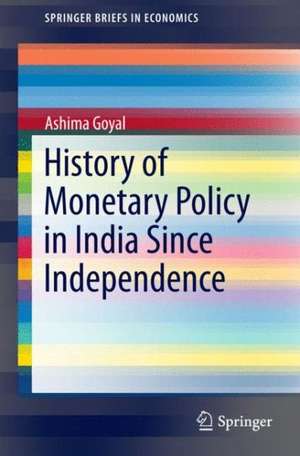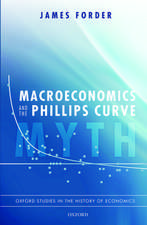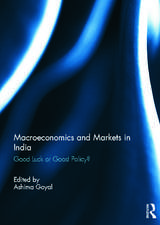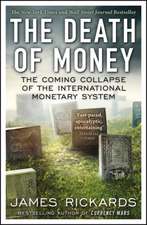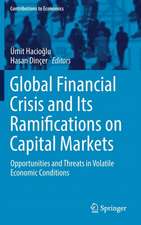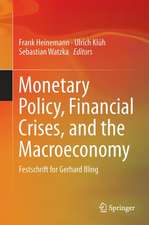History of Monetary Policy in India Since Independence: SpringerBriefs in Economics
Autor Ashima Goyalen Limba Engleză Paperback – 30 iul 2014
India’s greater openness is important both for it and for the world, but it occurred at a time of major global crises. How did these impact monetary choices and how did the latter help India navigate the crises while maintaining its trajectory towards greater liberalization? The book explores these and other relevant but under-analyzed questions.
The initial combination of ideas and structure created fiscal dominance and made monetary policy procyclical. An aggregate supply-and-demand framework derived from forward-looking optimization subject to Indian structural constraints is able to explain growth and inflation outcomes in the light of policy actions. Using exogenous supply shocks to identify policy shocks and to isolate their effects, demonstrate that policy was sometimes exceedingly strict despite the common perception of a large monetary overhang. Surges and sudden stops in capital flow also constrained policy.
But the three factors that cause a loss of monetary autonomy—governments, markets and openness—moderate each other. Markets moderate fiscal profligacy and global crises moderate market freedoms and ensure openness remains a sequenced and gradual process. The book argues greater current congruence between ideas and structure is improving institutions and contributing to India’s potential.
Din seria SpringerBriefs in Economics
-
 Preț: 444.35 lei
Preț: 444.35 lei -
 Preț: 264.79 lei
Preț: 264.79 lei - 15%
 Preț: 462.51 lei
Preț: 462.51 lei -
 Preț: 47.33 lei
Preț: 47.33 lei -
 Preț: 353.14 lei
Preț: 353.14 lei -
 Preț: 273.32 lei
Preț: 273.32 lei -
 Preț: 376.04 lei
Preț: 376.04 lei -
 Preț: 379.09 lei
Preț: 379.09 lei -
 Preț: 380.07 lei
Preț: 380.07 lei -
 Preț: 377.35 lei
Preț: 377.35 lei -
 Preț: 379.09 lei
Preț: 379.09 lei -
 Preț: 408.27 lei
Preț: 408.27 lei -
 Preț: 379.09 lei
Preț: 379.09 lei -
 Preț: 383.27 lei
Preț: 383.27 lei -
 Preț: 378.54 lei
Preț: 378.54 lei -
 Preț: 377.95 lei
Preț: 377.95 lei -
 Preț: 340.23 lei
Preț: 340.23 lei -
 Preț: 380.25 lei
Preț: 380.25 lei -
 Preț: 378.12 lei
Preț: 378.12 lei -
 Preț: 376.04 lei
Preț: 376.04 lei -
 Preț: 376.04 lei
Preț: 376.04 lei -
 Preț: 379.68 lei
Preț: 379.68 lei -
 Preț: 381.00 lei
Preț: 381.00 lei -
 Preț: 375.23 lei
Preț: 375.23 lei -
 Preț: 376.80 lei
Preț: 376.80 lei -
 Preț: 378.54 lei
Preț: 378.54 lei -
 Preț: 377.57 lei
Preț: 377.57 lei -
 Preț: 376.04 lei
Preț: 376.04 lei -
 Preț: 378.92 lei
Preț: 378.92 lei -
 Preț: 375.62 lei
Preț: 375.62 lei -
 Preț: 379.09 lei
Preț: 379.09 lei -
 Preț: 353.67 lei
Preț: 353.67 lei -
 Preț: 342.14 lei
Preț: 342.14 lei -
 Preț: 375.45 lei
Preț: 375.45 lei -
 Preț: 379.09 lei
Preț: 379.09 lei -
 Preț: 377.35 lei
Preț: 377.35 lei -
 Preț: 344.86 lei
Preț: 344.86 lei -
 Preț: 377.35 lei
Preț: 377.35 lei -
 Preț: 345.89 lei
Preț: 345.89 lei -
 Preț: 377.57 lei
Preț: 377.57 lei -
 Preț: 343.83 lei
Preț: 343.83 lei -
 Preț: 378.12 lei
Preț: 378.12 lei -
 Preț: 345.06 lei
Preț: 345.06 lei -
 Preț: 379.48 lei
Preț: 379.48 lei -
 Preț: 379.48 lei
Preț: 379.48 lei -
 Preț: 380.07 lei
Preț: 380.07 lei -
 Preț: 375.45 lei
Preț: 375.45 lei -
 Preț: 445.33 lei
Preț: 445.33 lei -
 Preț: 378.54 lei
Preț: 378.54 lei
Preț: 376.59 lei
Nou
Puncte Express: 565
Preț estimativ în valută:
72.06€ • 75.44$ • 59.63£
72.06€ • 75.44$ • 59.63£
Carte tipărită la comandă
Livrare economică 07-21 aprilie
Preluare comenzi: 021 569.72.76
Specificații
ISBN-13: 9788132219606
ISBN-10: 8132219600
Pagini: 92
Ilustrații: XIV, 78 p. 16 illus.
Dimensiuni: 155 x 235 x 5 mm
Greutate: 0.15 kg
Ediția:2014
Editura: Springer India
Colecția Springer
Seria SpringerBriefs in Economics
Locul publicării:New Delhi, India
ISBN-10: 8132219600
Pagini: 92
Ilustrații: XIV, 78 p. 16 illus.
Dimensiuni: 155 x 235 x 5 mm
Greutate: 0.15 kg
Ediția:2014
Editura: Springer India
Colecția Springer
Seria SpringerBriefs in Economics
Locul publicării:New Delhi, India
Public țintă
ResearchCuprins
Chapter 1: Structure, ideas and institutions.- Structure: Sectors, Growth and inflation, Politics, Government finances.- Ideas: Keynes modified, Monetarism in the aggregate, Globalization - ideas and domestic impact, New Keynesian theories in emerging markets.- Institutions: Precedents and path dependence, Strengthening institutions, Openness, markets and CB autonomy, Bank Governors and Delegation in India.- Chapter 2: Policy Actions and Outcomes.- The historical trajectory.- Excess demand or cost shocks?.- Openness, inflows and policy.- Money markets and interest rates.- The global crisis, response and revelation of structure.- Trends in money and credit.- Conclusion.
Notă biografică
Ashima Goyal, a professor at the Indira Gandhi Institute of Development Research, Mumbai, India, has widely published in institutional and open economy macroeconomics, international finance and governance and has participated in research projects with ADB, DEA-GOI, GDN, RBI, UN ESCAP and WB. She is the editor of the OUP Handbook on Indian Economy in the 21st Century, co-editor of a Routledge journal in Macroeconomics and International Finance, is active in the Indian public debate, has served on several boards and policy committees and is currently a member of the Monetary Policy Technical Advisory Committee. She was also a member of the Working Group on the Operating Procedure of Monetary Policy, 2010. Further, she was a visiting fellow at the Economic Growth Centre, Yale University, USA, and a Fulbright Senior Research Fellow at Claremont Graduate University, USA. Her research has received national and international awards. She won two best research awards at GDN meetings at Tokyo (2000) and Rio de Janeiro (2001); was selected as one of the four most powerful women in economics, a thought leader, by Business Today (2008); and was the first Professor P.R. Brahmananda Memorial Research Grant Awardee.
Caracteristici
Provides an analytical post-independence monetary policy history of India Focuses on the concepts, institutions and political economy of monetary policy in India Follows the sequence and explains the background of policy decisions Includes supplementary material: sn.pub/extras
